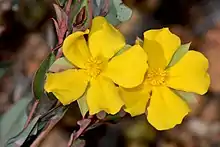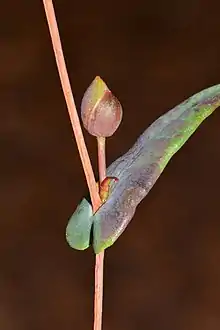Hibbertia amplexicaulis
Hibbertia amplexicaulis is a species of flowering plant in the family Dilleniaceae and is endemic to Western Australia. It is a prostrate, sprawling, straggling or ascending shrub that typically grows to a height of 0.1–0.6 m (3.9 in – 1 ft 11.6 in), rarely as tall as 1 m (3 ft 3 in). It blooms between August and March producing yellow flowers.[2] It was first formally described in 1845 by Ernst Gottlieb von Steudel in Lehmann's Plantae Preissianae.[3][4] The specific epithet (amplexicaulis) means "stem-clasping", referring to the leaves.[5]
| Hibbertia amplexicaulis | |
|---|---|
 | |
| Scientific classification | |
| Kingdom: | Plantae |
| Clade: | Tracheophytes |
| Clade: | Angiosperms |
| Clade: | Eudicots |
| Order: | Dilleniales |
| Family: | Dilleniaceae |
| Genus: | Hibbertia |
| Species: | H. amplexicaulis |
| Binomial name | |
| Hibbertia amplexicaulis | |

This species is found throughout the Peel, southern Wheatbelt, South West and Great Southern regions of Western Australia in coastal areas, swamps and ridges where it grows in sandy lateritic or granitic soils, often over limestone.[2]
See also
References
- "Hibbertia amplexicaulis". Australian Plant Census. Retrieved 23 March 2021.
- "Hibbertia amplexicaulis". FloraBase. Western Australian Government Department of Biodiversity, Conservation and Attractions.
- "Hibbertia amplexicaulis". APNI. Retrieved 23 March 2021.
- von Steudel, Ernst G.; Lehmann, Johann G.C. (ed.) (1845). Plantae Preissianae. Hamburg. p. 266. Retrieved 23 March 2021.
{{cite book}}:|first2=has generic name (help) - Sharr, Francis Aubi; George, Alex (2019). Western Australian Plant Names and Their Meanings (3rd ed.). Kardinya, WA: Four Gables Press. p. 131. ISBN 9780958034180.